This is Day 49 of our self-quarantine and Day 42 of KC’s Stay-At-Home order (currently set to end on May 15).
If the baseball season had proceeded as planned this year, all MLB players would have worn #42 on April 15 – the 73rd anniversary of the date Jackie Robinson broke the color line in major league baseball.
Two days from now is the 75th anniversary of Jackie’s first professional baseball game. It was played in Kansas City.
May 6, 1945 – Opening Day – Kansas City Monarchs: The Monarchs enjoyed years of success in Kansas City, and opening day was a major social event in the black community. On May 6, 1945, the festivities began at 2:00 on a Sunday afternoon with a parade led by the Wayne Minor American Legion drum and bugle corps. The game was played at 3:00 at Ruppert Stadium at 22nd and Brooklyn.
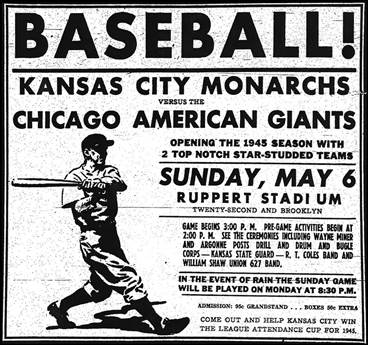
The Kansas City Star (and its morning edition, the Times) for years had rarely mentioned the team, leaving local coverage to the Kansas City Call. But the Monarchs consistently outdrew the Yankee farm team (the Blues), especially after Satchel Paige became a national celebrity, and so the Star added a little more Monarchs coverage in the 1940s. On the morning after opening day in 1945, one of the column headlines on the Times sports page read “Monarchs to 13,314.” That big crowd was treated to a Monarchs victory over the Chicago American Giants. The box score in the Times was a piece of history, but of course that was not known at the time. It showed Jackie Robinson in his first professional baseball game.
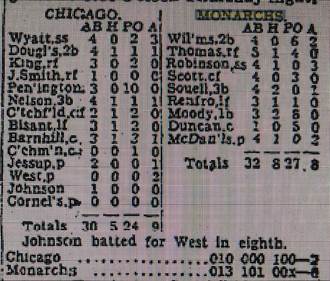
Jackie had been a multi-sport star at UCLA in the early 1940s and then was drafted into the army. While stationed in Texas, he got a tip from a fellow soldier that he should contact the Monarchs for a job after being discharged. This led to Monarchs owner J. L. Wilkinson signing Jackie in March of 1945. Below, Jackie with Satchel Paige.
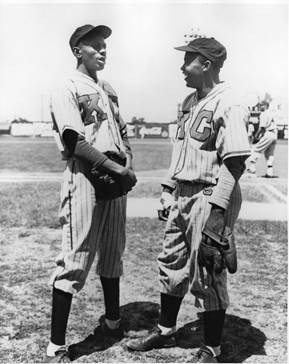
Jackie hit .387 for the Monarchs in 47 games before leaving the team in late August when he made a deal with Branch Rickey of the Dodgers. The two agreed on the terms of a contract for Jackie to play for the top Dodgers farm team, the Montreal Royals. However, it was to be a handshake deal until later that year, and the parties were not to tell anyone until a contract was actually signed. Robinson headed home to Pasadena and filled in some of his time by playing for the Kansas City Royals (not a typo).
Barnstorming 1945 – Kansas City Royals: The California Winter League had existed since the turn of the century and included teams of white and black players (but not integrated within any team). Play began after the MLB season and drew the likes of Stan Musial, Ted Williams and Bob Feller. One of the barnstorming teams in the league was the Kansas City Royals, a name chosen by Chet Brewer, a former Monarch who managed the team. Brewer often hired Monarchs players, and in 1945, this included Jackie Robinson and Satchel Paige. Below, Jackie in his Kansas City Royals uniform.

The Baseball Hall of Fame has a scorecard for a Royals game on October 24, 1945. The game was played against Kent Parker’s All Stars in San Diego. The starting pitchers were Satchel Paige and Bob Feller. Jackie is listed at shortstop and batting cleanup. But he did not play in the game. The previous day, he was at a press conference in Montreal when the Dodgers announced that Jackie had signed a contract to play for Montreal in 1946.
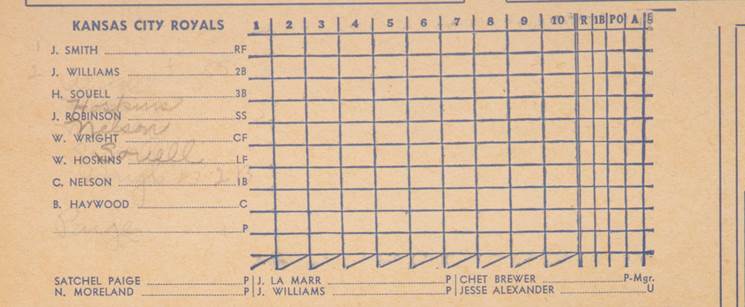
April 18, 1946 – Opening Day – Montreal Royals: Jackie moved from one Royals team to another. The Montreal Royals opened the 1946 season on the road April 18 at Roosevelt Stadium in Jersey City. It was the first time in the modern era for an African American to play in “organized” baseball, minor or major league.
Jackie went four for five in the game. One of the hits was a three-run homer, and it created a photo op that went down in history. When Jackie crossed the plate, he received a congratulatory handshake from the next batter, George Shuba – a white player shaking hands with a black teammate on the diamond. The gesture was captured in an AP photo that became famous. In Shuba’s obituary in the New York Times in 2014, the headline read “George Shuba, 89, Dies; Handshake Heralded Racial Tolerance in Baseball.”

Jackie had a big season for the Royals, and the team went on to win the Little World Series against Louisville. At the games in Louisville, Jackie was treated badly by the local fans and he was not allowed to stay in the team hotel. The opposite was the case in Montreal. When the final game ended, the fans rushed the field and sang Il a gagne ses Epaulettes (“He won his bars”) and screamed “We want Robinson” until he emerged from the dugout. They hugged and kissed Jackie, and hoisted him on their shoulders. He needed to rush to get to a plane, but the crowd kept following him, prompting sportswriter Sam Maltin to say “it was probably the only day in history that a black man ran from a white mob with love instead of lynching in mind.”
April 15, 1947 – Opening Day – Brooklyn Dodgers: On April 15, 1947, at Ebbets Field in Brooklyn, Jackie Robinson broke the color line in major league baseball. Below, on that date, John Jorgensen, Pee Wee Reese, Eddie Stanky and Jackie Robinson.
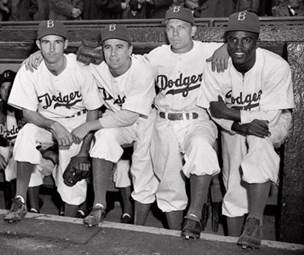
He was Rookie of the Year in 1947 and MVP in 1949. His Hall of Fame career ended in 1956. Thank you #42.
Derby Day – 2020: The 146th running of the Kentucky Derby was scheduled for two days ago, May 2, but the race has been postponed to September 4 because of the pandemic. For now, the traditional song has new lyrics, “My Old Kentucky Stay-At-Home.”
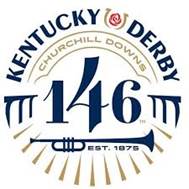
This is the first time that the Derby has not been held in May since the wartime year of 1945. When Pearl Harbor brought the U.S. into World War II, there was a question if pro sports would continue. President Roosevelt sent Commissioner Landis a “green light” letter to approve continuing with baseball (the draft still applied and many players served in the war). Other sports likewise continued, including horse racing which was highly popular and a major legal gambling outlet. But in January of 1945, the government determined that the resources and workforce required for racing could better be applied to the war effort. And gambling money could be used to buy war bonds. This set up an interesting week in early May of 1945:
Saturday, May 5: Originally scheduled date for the Kentucky Derby. No race, nor a specific new date since the war was still on.
Sunday, May 6: Jackie Robinson opened the season with the Monarchs. Baseball was not banned at all.
Tuesday, May 8: Germany surrenders, giving the Allies a victory in Europe. V-E Day! The ban on horse racing was quickly lifted and Churchill Downs moved to reopen. The Derby was run on June 9 – the winning horse was Hoop Jr. ridden by Eddie Arcaro.
This past Saturday, with no current race to televise, NBC ran a 3-hour show of “Kentucky Derby Classics.” They revisited 2015 to feature Triple Crown winner, American Pharaoh, who then joined the other 12 Triple Crown winners in an animated/simulated virtual Kentucky Derby. The algorithm favorite for the simulation was Secretariat, and he did indeed win. Watch it here (2:31).
Rita and I celebrated this year’s non-race at a socially-distanced cocktail hour at the home of Randy and Beth Nay. We took our own wine, glasses and snacks. Below, Rita with our hosts and Beth’s dad, Ed Drill.
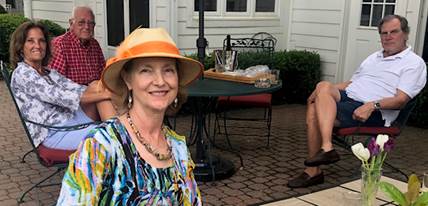
About Rita’s hat. We were on a cruise of the Persian Gulf in 2009. One of our stops was Dubai, and it was the week of the Dubai World Cup, the biggest horse racing event in that part of the world. Several Australian and London hat makers set up temporary hat souks. Hats go with big races anywhere, be it Churchill Downs, the Ascot Racecourse in the U.K. or Dubai. We weren’t going to the race, but Rita could not pass up the chance to buy a hat directly from the designer (one of the Aussies). I can’t talk about my long-necked wife with a derby chapeau without thinking about Aubrey Hepburn at the Ascot race in My Fair Lady (enjoy that here).
Derby Day – Fifty Years Ago: (1970): Fifty years ago, I was part of a group of sponsors who hosted their 6th annual Derby Day Party. The hosts, mostly then-young trial lawyers, were continuing what started as a small back yard party in 1965. It grew to several hundred before wearing out and ending in 1975.

The winner of the 1970 Kentucky Derby was a 16-1 long shot named Dust Commander (see the exciting come-from-behind victory at this link).
But the race is probably remembered more as the setting for “The Kentucky Derby is Decadent and Depraved,” a magazine essay by Hunter S. Thompson in Scanlan’s Monthly. Thompson was a native of Louisville and had been to the Derby many times. So he had some experience with the scene he described. But he told the story of the Derby in a whole new way. He wrote almost nothing about the horse race, but instead wrote an alcohol-fueled stream-of-consciousness piece – a first-person narrative combining social critique, self-satire and loads of sarcasm, humor, exaggeration and profanity. Thompson’s piece is considered the first instance of Gonzo journalism – the author and style of the piece became more important than the event.
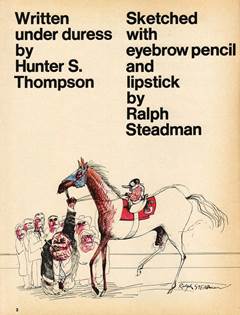
The essay is available online (click here). A sampling:
“I pointed to the huge grassy meadow enclosed by the track. That whole thing…will be jammed with people; fifty thousand or so, and most of them staggering drunk. It’s a fantastic scene — thousands of people fainting, crying, copulating, trampling each other and fighting with broken whiskey bottles…this clubhouse scene right below us will be almost as bad as the infield. Thousands of raving, stumbling drunks, getting angrier and angrier as they lose more and more money. By midafternoon they’ll be guzzling mint juleps with both hands and vomiting on each other between races. The whole place will be jammed with bodies, shoulder to shoulder. It’s hard to move around. The aisles will be slick with vomit; people falling down and grabbing at your legs to keep from being stomped. Drunks pissing on themselves in the betting lines. Dropping handfuls of money and fighting to stoop over and pick it up.”
As a veteran of Derby Day parties in Kansas City, I have seen the effect of mint juleps on people who drink them only one day a year. In reading the above passage, I’m pretty sure none of our parties involved a fight with broken whiskey bottles. But we were raided by the Kansas City Vice Squad in 1973 when Secretariat won the Triple Crown. We got off with a warning about the mixing of booze and gambling.
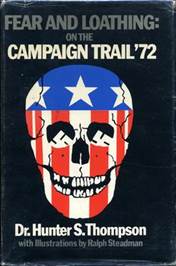
What I remember about Hunter Thompson from his early days was his coverage of the 1972 presidential election in Rolling Stone. The essays were collected in a 1973 book titled Fear and Loathing: On the Campaign Trail ’72. Rolling Stone writer Timothy Crouse also covered the campaign, and his follow-up book was The Boys on the Bus. As a relative newcomer to politics at that time, these two books meant much more to me than the traditional campaign recap by Theodore White (The Making of the President 1972). White no doubt is the better historical record. Thompson and Crouse went behind the scenes with the staff and press and made politics sound like fun. And in 1976 I got to live it as a volunteer advance man for Walter Mondale in his race for the vice presidency.
I still have all three of these books. On the back cover of Fear and Loathing, there is a photo of Thompson and candidate George McGovern (below). The caption is “The Author explaining to George McGovern why he cannot accept his offer of the Vice Presidency, on board the McGovern Victory Special during the California Primary in June 1972.”
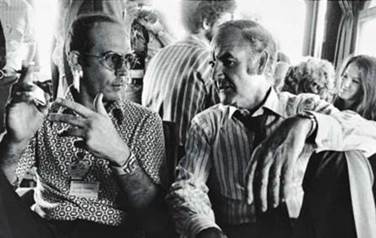
Hunter S. Thompson Trivia: Thompson’s celebrity was amplified in 1974 when “Duke” became a recurring character in Doonesbury strips. Duke started as a parody of Thompson, a drug-addled Rolling Stone writer missing deadlines and submitting incoherent copy. A cigarette holder hung from his lips. And Raoul Duke was a pseudonym that Thompson used for himself in many of his writings. Thompson was not amused at being the subject of caricature.
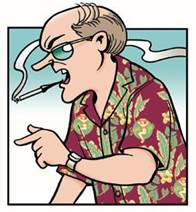
Duke soon evolved into a character who had little to do with Thompson (other than the trademark cigarette holder). Over the decades, Duke has contrived a series of debauched schemes, often in international locales. Doonesbury creator Gary Trudeau describes Duke as an opportunist who bases all decisions on one simple question: “Is this is my self-interest or not?” Duke was appointed by President Ford as the U.S. Ambassador to China, but was recalled by President Carter. In 2000, Duke ran for president and appeared on Larry King (click here) and participated in a debate with Bush and Gore moderated by Jim Lehrer (click here).
In a series of strips 32 years ago (1988), Trudeau gave Duke the job of captaining Donald Trump’s luxury yacht. Duke did not have to do a lot because Trump’s fear of ocean travel kept the yacht moored off his various failing casinos.
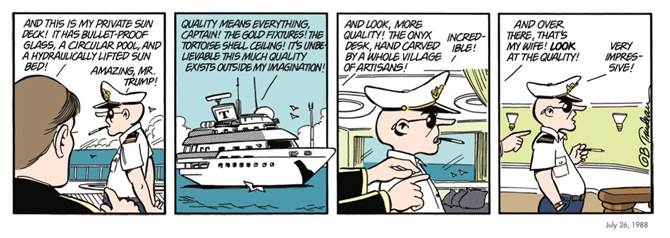
House Calls: Rita and I expanded our walking horizons beyond the Plaza. We drove to the Meyer Fountain area and walked some long blocks between State Line and Ward Parkway. And rang some doorbells.
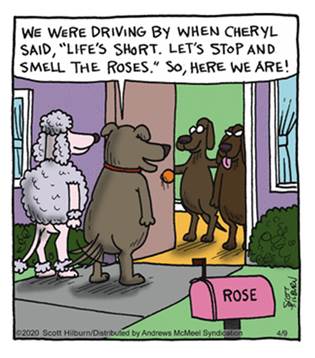
I’ll start with Jim Fitzpatrick, Kansas City’s almost Hunter Thompson. Like Thompson, Jim is a journalist who grew up in Louisville and has been to the Derby many times. But Jim’s take on the Derby sounds more sentimental than Gonzo. He wrote Saturday in his blog “that the best part of the Derby is not the race but the atmosphere – the tidal wave of joy, excitement and energy that comes with and assembly of 150,000 people all primed to cut loose and have fun and most dressed in the fanciest and most creative outfits they could come up with.” For Jim’s full post and photos, click here for JimmyCsays. When we rousted Jim from his house, he wore his hat in honor of (postponed) Derby Day.
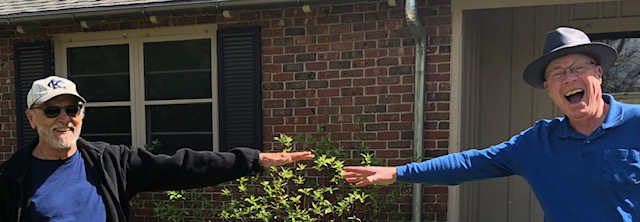
Cheryl Dillard honored her Mizzou Tigers. Pat was out riding his bike.

Doc Worley, humorist and entrepreneur.
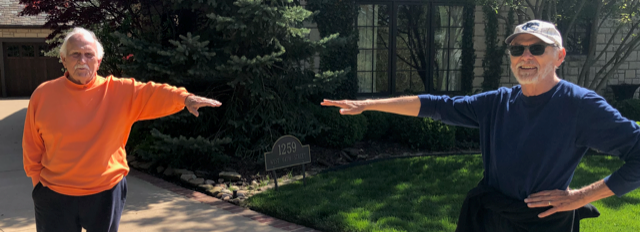
David Welte, my good friend since law school and one of my fellow KC Derby Day sponsors. In real life, I am not taller than David.

Lonnie’s Jukebox – Gregorian Chants (Week 6): KC Star sportswriter Vahe Gregorian continues his daily tweets of quarantine songs. Click on the song title to listen.
Day 36 (April 28) of Stay-At-Home Order: “Maple Leaf Rag” by Scott Joplin. Vahe said this one was for “my Mama, Clare, who played it so wonderfully and died two years ago today.”
When I hear Scott Joplin’s music, my mind goes to the 1973 film The Sting (in my top-ten list) and its wonderful Marvin Hamlisch score of Scott Joplin music. The soundtrack album went to #1 and the big single off the album was “The Entertainer.” The movie won seven Academy Awards, including Best Picture and Best Music Score.
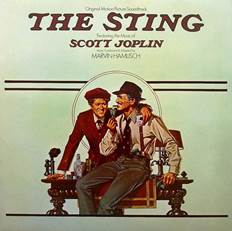
Day 37: “The Promised Land” by Bruce Springsteen. In case you have not noticed, Vahe is a Springsteen fan. As for where we are until we reach the promised land…
Day 38: “No Man’s Land” by Bob Seger & The Silver Bullet Band. “They’re all out there in no man’s land/Cause it’s the safest place to be.”
Day 39: “Gonna Fly Now” by Bill Conti. The theme song for Rocky, Oscar winner for Best Picture in 1976. The song went to #1 on the Billboard Top 100. This is one of the anthems being used by hospitals to celebrate victories during the pandemic.
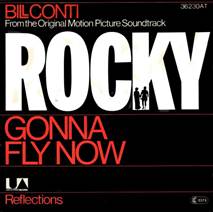
Day 40: “Horse With No Name” by America. Day 40 is May 2, the day the Derby was to be run. So Vahe picked this song “for our own strange journey and, alas, this year’s Kentucky Derby winner.”
Day 41: “Days Like This” by Van Morrison. “Oh my mama told me/There’ll be days like this.”
Day 42: “Manic Monday” by Prince. It’s Monday, May 4. Vahe’s tweet: “If only it were a ‘Manic Monday’.”
Vahe linked the recording made by Prince in 1984, but which was not available until 2019 as part of the estate’s release of archival vault originals. It was one of several songs written by Prince for other artists while he was working on Purple Rain. The Bangles’ Susanna Hoffs said that getting “Manic Monday” from Prince “was like putting on the slipper in a fairy tale.” Click here to play the Bangles cover. In 1986, it went to #2 (the #1 song that week was Prince’s “Kiss”).
Bonus Clip: Eric Adler and Vahe Gregorian wrote the lead front page story in yesterday’s Kansas City Star, profiling seven victims who had died because of COVID-19. One was Marvin Jackson, a musician, entrepreneur and preacher who died at the age of 60. When in middle school in the 1970s, Marvin and his brother Clifford Jackson (also a preacher) were part of the Lincoln Junior Boys, a drill team led by the legendary Willie Arthur Smith. The drill team later became known as the Kansas City Marching Cobras. In 2014, over 40 years after being on the drill team, the two brothers were at Clifford’s church and so was Willie Arthur Smith. With no rehearsal since 1973, the brothers snapped to Smith’s commands in unison as if they were once again at Lincoln Junior High. As Eric Adler tweeted, “There is a 100% joyful smile in one of these mini profiles…I guarantee 100% you’ll love it. I’ve watched it 15 times.” I agree with Eric, but have not yet reached 15. But I’ll get there. Click here (2:06; Marvin Jackson is the taller of the two marchers).